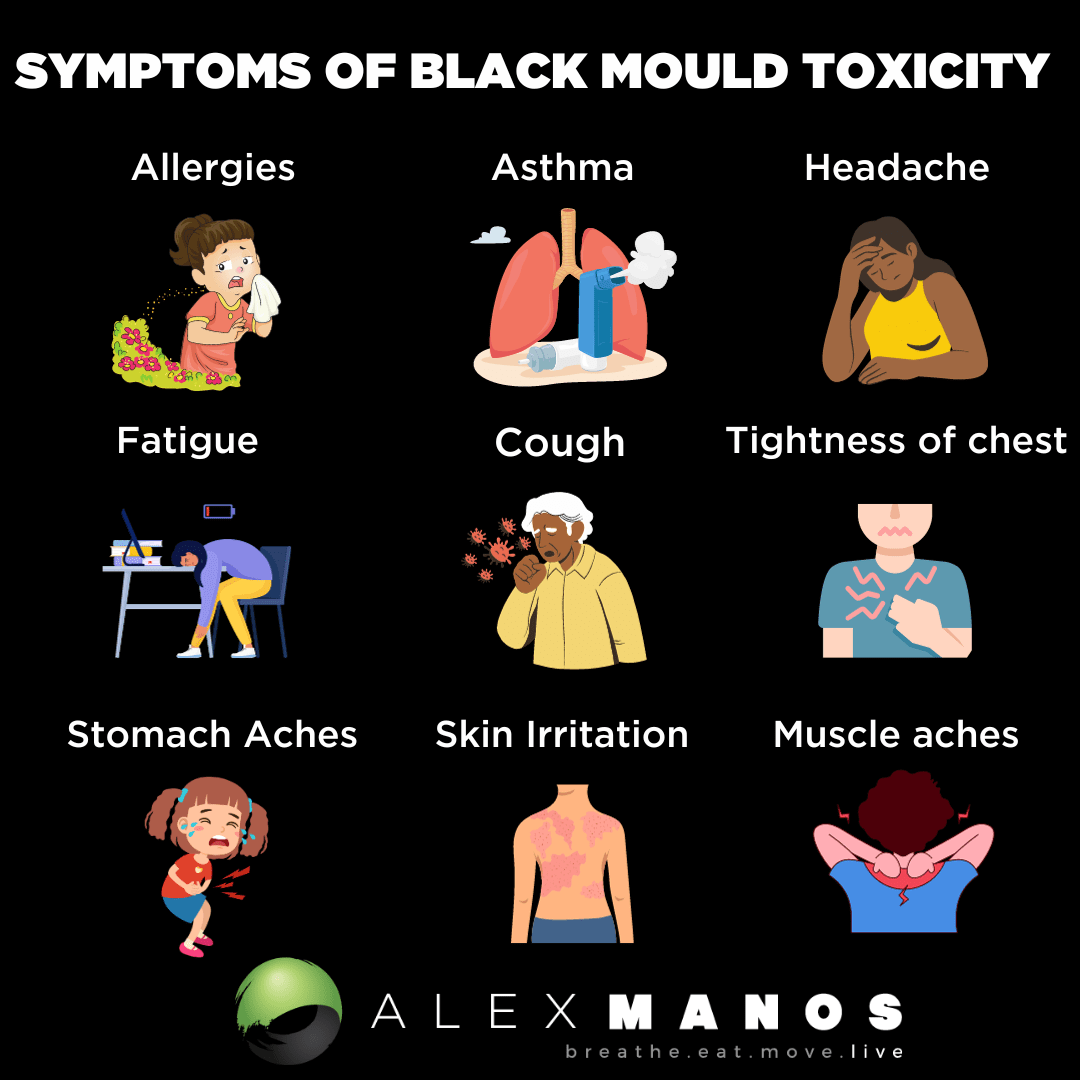Black Mould Symptoms:
- Symptoms can include:
- Sick building syndrome.
- Agranulocytic anaemia (low neutrophil levels).
- Asthma.
- Nasal bleeding.
- Allergies.
- Inflammation.
- Lung injury.
- Pulmonary hypertension.
- Irritation of the skin and/or mucous membranes.
- Headache.
- Fatigue.
- Cough.
- Burning nasal passages.
- Tightness of chest.
- Muscle and stomach aches. (source)
See below for more information around black mould symptoms.
What Is Black Mould?
Black mould is a fungus called Stachybotrys chartarum.
Among the 123 known species of Stachybotrys, Stachybotrys chartarum, which I will call black mould throughout the rest of this article, deserves special attention.
It is one of the world’s 10 most hazardous fungi. Black mould is so well known due to the metabolites that are released, including certain mycotoxins. It is the interaction of these metabolites with our own cells (especially in the respiratory or digestive tract and with skin) that can cause the above-mentioned symptoms or conditions. (source)
It’s been estimated that people spend approximately 90% of their lives indoors. That’s a pretty depressing statistic, which is made worse by the fact that, unfortunately, the quality of indoor air might be as problematic (if not more problematic) than outdoor air. There is a surprising amount of evidence around this.
Returning to mould, it is commonly known that many respiratory symptoms are associated with staying in homes that have humidity problems and the presence of mould. I wrote about this more in my blog 10 Warning Signs Of Mould Toxicity.
Since 1993, when black mould was discovered as a cause of acute pulmonary haemorrhage in infants from Cleveland, Ohio, the interest in black mould exploded. (source)
How Are We Exposed To Black Mould?
People can be exposed to this mould via skin contact, ingestion, and inhalation.
As a random aside, it has also been found in damp, improperly stored straw or hay (source), and I have worked with a few clients who work with horses where we suspect exposure has contributed to their symptoms.
Mycotoxins From Black Mould
Black mould is capable of producing mycotoxins, which can be divided into three groups:
- Macrocyclic trichothecenes.
- Atranones
- Immunosuppressive phenyl spirodrimanes.
It is commonly known that most of the mycotoxins related to this species are very harmful for humans. (source)
It’s important to note that the Centers for Disease Control and Prevention (CDC), due to the lack of complete documentation of pulmonary haemorrhage cases, does not allow for the conclusion that black mould unequivocally was the cause.
I agree with the authors of the paper, though, when they said that “it is impossible not to notice that 91% of the 52 cases of infant pulmonary haemorrhage described so far have been associated with the presence of black mould in the homes of the studied patients.”
Preventing Black Mould Growth – Know Your Environment
Black mould is not only a damp building-related fungus found under special conditions; this fungus is much more common than it might be assumed and is favoured by relatively high humidity and cellulose-rich materials.
The lowest relative humidity supporting mould growth is approximately 75%, although the requirements of black mould are much higher, around 93% at 25°C. Increasing temperature and nutritional status of the substrate (the material the mould is growing on) can lead to lower moisture requirements. (source)
This is why, in numerous blogs, I have mentioned how helpful it can be to have a hygrometer to measure the humidity in your home. If above 75% (some say 50%!), then I would recommend a dehumidifier.
This black mould is able to grow in a range of pH 3.0–9.8; however, the optimal pH for this fungus is in the range of 5.6–6.0. The optimal temperature for growth is in the range of 20–25 °C, although this fungus can grow even at a temperature of 2.5 °C but can’t at temperatures above 37 °C. (source)
It Will Impact Your House
Indoor mould growth is a consequence of moisture from water damage, water leaks, condensation, water infiltration, improper humidity prevailing in premises, or flooding. I recommend Pure Maintenance UK who offer a brilliant service around mould inspection and remediation.
Mould growth begins when water is moistening porous materials for longer than a 48-hour period. However, so-called tertiary colonisers like black mould require a high water activity and a high humidity (aw > 0.9 and RH > 90%) to grow and constant moisture for active growth.
S. chartarum, due to its outstanding cellulolytic abilities and predisposition to develop on materials rich in cellulose, such as wood, fiberboard, gypsum board, polyurethanes, cellulose fabrics, and paper, is also the object of special attention as a biodeterioration factor.
Black mould belongs to the group of fungi often referred to as “soft rot fungi.” These fungi cause changes in wooden building materials, resulting in weight and stability losses of wood, albeit to a very limited extent compared to brown rot fungi.
Like other moulds, it often occurs in the areas of the so-called “thermal bridges” where water vapour condenses. (source)
Recommended Products
Conscious spaces have some brilliant products including a spray, a detergent and cleaning wipes. All powered by their lab-tested and proven blend of citrus seed extracts.
Black Mould Poisoning Symptoms
“This fungus is particularly important because it is one of a series of fungi that produces trichothecenes mycotoxins; these mycotoxins are biologically active and can produce a variety of physiological and pathologic changes in humans and animals, including modulation of inflammation.” (source)
In humans, the health impact of exposure to Stachybotrys genus is limited, but we can find many reports in the medical literature on the harmful effects related to black mould.
When black mould spores enter the digestive system, symptoms such as burning in the mouth, nausea, vomiting, diarrhoea, and abdominal pain appear.
Here is a list of evidence-based (source) symptoms associated with black mould poisoning:
- Pulmonary haemorrhage.
- Gastrointestinal haemorrhage.
- Sick building syndrome.
- Mycotoxicosis (stachybotryotoxicosis).
- Leucopenia.
- Lymphadenopathy.
- Agranulocytic anaemia.
- Asthma.
- Adult nasal and tracheal bleeding.
- Allergies.
- Inflammation.
- Lung injury.
- Pulmonary hypertension.
- Pulmonary arterial remodelling.
- Irritation and necrotic changes within skin and/or mucous membranes.
- Hypersensitivity pneumonitis (repeated inhalation of conidia).
- Neurotoxicity.
- Inhibitory activity against the complement system.
- Headache.
- Fatigue.
- Cough.
- Burning nasal passages.
- Tightness of chest.
- Muscle and stomach aches.
The authors of this paper mentioned one case report where an 80-year-old immunocompetent male had a black mould infection of the scalp. It’s important to mention that the authors did state that the case report was poorly documented. (source) But this report does suggest that superficial infections may be possible with black mould.
It is also worth noting that both dead and alive spores aggressively irritate the skin and respiratory tract and thus contribute to black mould symptoms.
Don’t Blame Just Black Mould
Black mould is almost never found in isolation, nearly always occurring in the presence of other fungi.
This is really important to understand as many other species of mould are capable of producing mycotoxins. In fact, recent research suggests that metabolites from black mould may represent a small percentage of the total amount present in water-damaged buildings where other fungi exist. (source)
You Need To Know This About Mycotoxins
It’s so important to understand that the presence of potentially toxic mould does not imply the presence of mycotoxins.
Mycotoxin production is dependent on substrates, nutrient levels, moisture, pH, and temperature. While many species of mould can produce mycotoxins, the ability to produce mycotoxin varies under these conditions (source).
As a result, often “known” toxin producers will not make these compounds.
In addition, many unknown secondary metabolites, yet to be detected or identified, can be produced, and new compounds are constantly being identified.
Natural Anti-Fungals For Black Mould
“We currently have a lot of information on the antifungal activity of essential oils toward black mould.” (source)
In a fascinating study, the researchers assessed the antifungal activity of twenty essential oils. They found that oregano oil, thyme, and red passion flower were similar in potency as some synthetic fungicides used in medicine and agriculture. (source)
Other research has also found this to be the case. In one paper, the authors discussed thyme and how it has a pronounced antifungal effect on black mould.
But here is a warning! There is also a report that found black mould on dried tissues of this plant, which suggests the contamination of harvested herbs and colonization with this mould.
Tea tree oil also shows antifungal properties against some black moulds. (source)
Petri Dish Testing For Black Mould
While it is possible to collect mycotoxins by using air filters followed by extraction, they are usually isolated from dust samples or building materials. A key thing to understand here is that this may misrepresent exposure since the compounds are not volatile.
In the case of black mould, the spores are produced in a slimy mass with a high moisture content. As a result, they only become airborne when dry and disturbed or when attached to other particles, such as dust. If you are going to do one of these tests, then consider ‘disturbing’ your environment (shake curtains, hit pillows, slide your feet over carpet etc etc).
Summary
“Due to the fact that S. chartarum is one of the world’s 10 most feared fungi, and the problematic issues raised in this paper have not yet been explained, it seems justified to pay attention to this black mould”. (source)
As discussed in this article, we know that black mould doesn’t seem able to grow at a temperature ≥ 37 °C. Studies are desperately needed to explore whether invasive growth inside the human body is possible.
But, as mentioned above with the 80-year-old man, we do know that superficial infections of the skin (scalp) is possible.
A key point in the research is that it is highly likely that the symptoms and conditions caused by black mould are related to secondary metabolites, including mycotoxins. (source)
It therefore feels that the question around whether black mould itself causes health issues is not the right question. Some researchers seem to focus on the actual fungus rather than the metabolites it produces. So perhaps a better question to ask is whether the mycotoxins produced from black mould can cause human health issues, and the answer is a simple yes, significant ones!
Alex is a certified Functional Medicine Practitioner (IFMCP) and has a MSc in Personalised Nutrition. He is also a breathwork facilitator with a background in personal training and massage therapy. He also runs The Resiliency Program - a 24 week program aimed at building physical, mental, emotional, and spiritual resilience.








